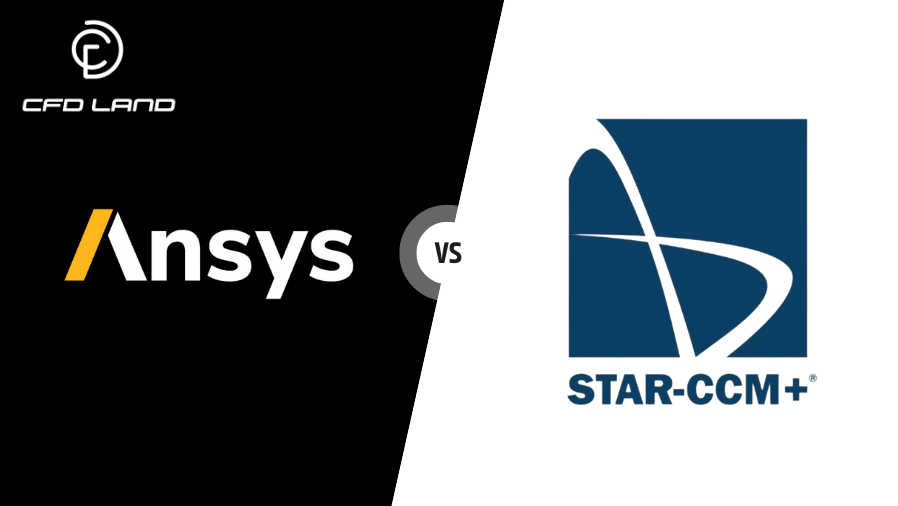Ansys Fluent and STAR-CCM+ are powerful Computational Fluid Dynamics (CFD) software tools for simulating fluid flow and heat transfer. Sometimes, we don’t know which software appropriately fulfills all our needs. Evaluating each software’s specific features and capabilities regarding your project needs is essential before deciding. In this article, we explain the key features of Ansys Fluent and Star CCM+ and then summarize the differences between them.
Contents
ToggleThe choice between them often depends on the project’s specific requirements, such as the type of physics involved, ease of use, and the level of detail needed in the simulations.
It is recommended that you visit the CFD Project to learn more about the projects that Ansys Fluent software could handle.
ANSYS Fluent Features: A Powerful CFD Software
Ansys Fluent is known for its extensive physics modeling capabilities and user-friendly interface, making it suitable for a wide range of applications. ANSYS Fluent is a comprehensive computational fluid dynamics (CFD) software package that offers a wide range of features for simulating fluid flow and heat transfer phenomena as below:
- Intuitive Interface and workflow: Fluent’s user-friendly interface, including both GUI and TUI options, simplifies complex simulations.
- Advanced Physics Modeling: Supports a variety of physics models, such as turbulence, multiphase flow, and heat transfer with customizability, enabling accurate simulations of complex systems.
- Robust Meshing and CAD Capabilities: Provides powerful meshing tools, including poly-hexacore meshing and parallel processing, to generate high-quality meshes efficiently.
- Efficient Solvers: Offers a range of solvers, including steady-state, transient, segregated, and coupled solvers, to handle various simulation types.
- Comprehensive Post-Processing: Provides advanced post-processing tools to visualize and analyze simulation results, including contour plots, streamlines, and particle tracks.
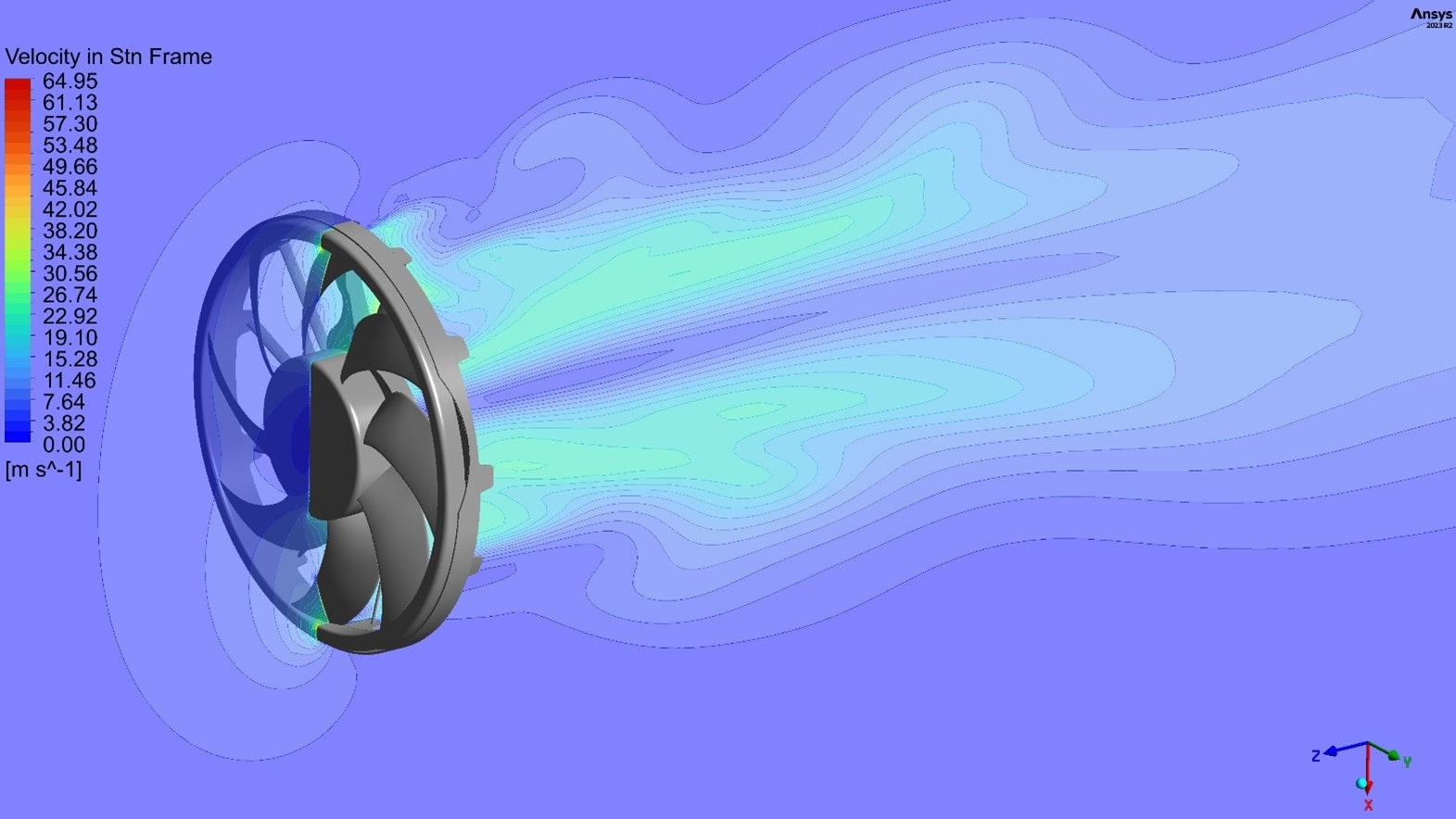
Figure (1) Fluent post-processing example
With its versatility and powerful features, ANSYS Fluent is a valuable tool for engineers and researchers in various industries, including aerospace, automotive, energy, and manufacturing.
STAR-CCM+ Features: A Powerful Multiphysics Simulation Tool
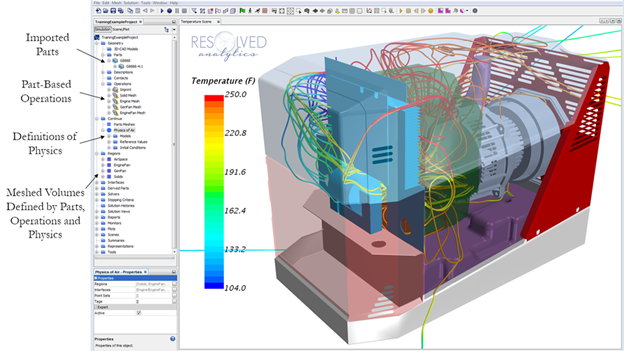
Figure (2) STAR-CCM+ User Interface , Source: https://www.resolvedanalytics.com
STAR-CCM+ offers a more integrated environment with excellent support for complex geometries and multiphysics simulations. STAR-CCM+ is a leading computational fluid dynamics (CFD) and computational mechanics software package used to simulate a wide range of physical phenomena as below:
- User-friendly Interface and Workflow: A modern and intuitive interface simplifies complex simulations.
- Multiphysics Capabilities: Simulates multiple physical phenomena, including fluid flow, heat transfer (conduction, convection, radiation models), stress analysis, and electromagnetics, aeroacoustics, and reaction chemistry with Chemkin integration.
- Advanced Meshing: Offers powerful meshing tools for generating high-quality meshes, including tetrahedral, polyhedral, and trimmed cell meshes.
- Robust Solvers: Provides both segregated and coupled solvers for efficient simulations.
- Comprehensive Post-Processing: Powerful visualization tools for analyzing simulation results, including contour plots, streamlines, and particle tracks.
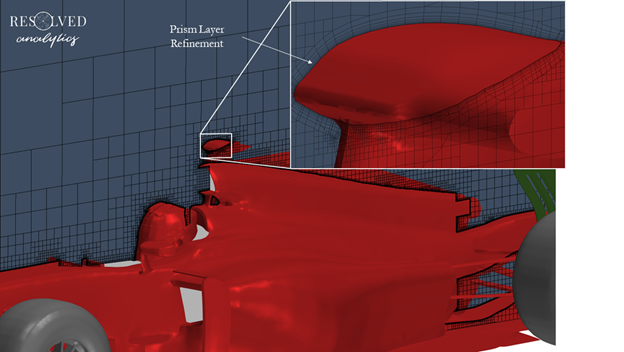
Figure (3) STAR-CCM+ high-density prismatic meshing of boundary layers, Source: https://www.resolvedanalytics.com
With its versatility and powerful features, STAR-CCM+ is used by engineers and researchers in various industries, including automotive, aerospace, and energy.
Comparison Between ANSYS Fluent and STAR-CCM+

Figure (4) Comparing Star CCM+ and Ansys Fluent, Source: https://www.youtube.com/watch?v=o8n4ki_d1fA
According to this article, here’s a comparison table summarizing the interface, usability, capabilities, meshing, simulation performance, post-processing, and pros and cons of ANSYS Fluent and STAR-CCM+:
| Aspect | ANSYS Fluent | STAR-CCM+ |
| Interface and Usability | Familiar and versatile, with options for both GUI and TUI. | Intuitive, with an integrated all-in-one interface. |
| Capabilities in Physics Modeling | Excels in flexibility with UDFs and hybrid models. | Superior in multiphase and solid-fluid interactions. |
| Meshing Capabilities | Modern poly-hexacore meshing with parallel processing support. | Advanced polyhedral and prism layer meshing. |
| Simulation Performance | Includes cloud support and notable GPU-based enhancements for improved performance. | Supports parallel processing with integrated batch processing options. |
| Post-Processing Strengths | Offers state-saving in CFD-Post and rich visualizations through Ensight. | Exceptional real-time visual feedback and advanced visualization tools. |
| Pros | – Comprehensive modeling options. – Flexible UDF support. – Strong community and customer support. |
– User-friendly interface. – Strong multi-physics integration. – Validated numerical methods. |
| Cons | – Requires standalone software for some CAD tasks. – Potentially slower meshing for larger models. |
– High initial cost. – Potentially steep learning curve for new users. |
This table helps in comparing ANSYS Fluent and STAR-CCM+ with a focus on their distinct strengths and limitations.
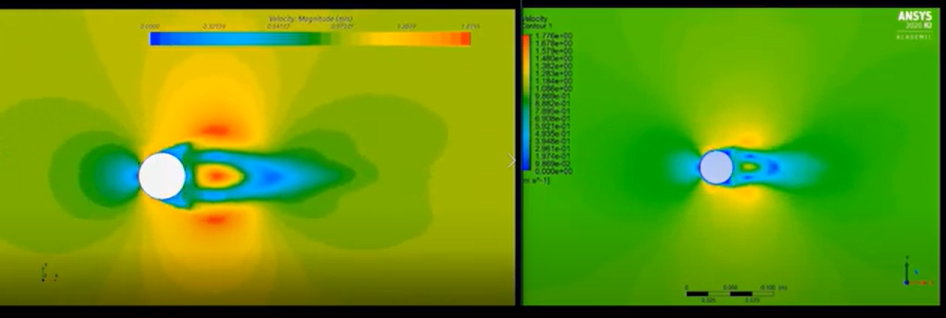
Figure (5) Comparison of Ansys Fluent and Star CCM+ for simulating, Source: https://www.youtube.com/watch?v=o8n4ki_d1fA
Meanwhile, there was a study in 2018 by Zou, Y., Zhao, X., and Chen, Q. about “Comparison of STAR-CCM+ and ANSYS Fluent for simulating indoor airflows,” were compared in terms of grid-independent solutions; turbulent viscosity calculations; heat transfer coefficients as determined by wall functions; and complex flow with complicated boundary conditions. The two programs produced almost the same results with similar computing effort, although ANSYS Fluent seemed slightly better in some aspects.
This study used STAR-CCM+ and ANSYS Fluent to simulate several indoor airflow problems with the same mesh and boundary conditions, and the simulated results were compared with each other and with experimental data.
The investigation led to the following conclusions:
- The two CFD programs reached grid-independent solutions with the same mesh size, and the accuracy of the predicted results was similar.
- Although the programs calculated the turbulent viscosity differently, the resultant distributions of air velocity, air temperature, and turbulence kinetic energy were nearly identical.
- The two programs used different wall functions for temperature. The results obtained by the two programs showed that the finer the grid, the more accurate the heat transfer coefficient. The enhanced wall treatment used in ANSYS Fluent calculated a heat transfer coefficient that agreed with the experimental data.
- The CFD programs calculated complex airflows with similar accuracy. ANSYS Fluent performed slightly better, and its user-defined functions were more user-friendly.
Here’s a summary table of the main pros and cons of ANSYS Fluent and STAR-CCM+ based on the study:
| Aspect | ANSYS Fluent | STAR-CCM+ |
| Main Pros | – Robust solver algorithms (e.g., pressure-based coupled algorithm). | – Ability to import Fluent case files, preserving mesh data. |
| – Validated and reliable simulation results. | – User-friendly workflow with simplified setup and physics model selection. | |
| – Broad physics modeling options, including RANS and Spalart-Allmaras. | – Good correlation with Fluent for normal force and pitching moment. | |
| Main Cons | – Complex initial setup and dependence on high-quality mesh preparation. | – Challenges with coupled solver implementation, affecting accuracy for complex boundary flows. |
| – Performance can be mesh-dependent, requiring external tools for geometry and mesh setup. | – Limitations in modifying imported mesh; no mesh continuum created upon import. | |
| – Notable discrepancies in axial force predictions, especially at higher angles of attack. | ||
| Ideal Use Case | Effective for highly detailed, validated simulations with comprehensive solver options. | Suitable for streamlined workflows and projects where Fluent case file imports are beneficial. |
This table highlights the core advantages and drawbacks of both CFD tools, guiding users in choosing the best option based on their specific project needs.

Figure (6) Is Ansys Fluent better than Star CCM+? , Source: https://www.youtube.com/watch?v=o8n4ki_d1fA
Besides, according to Techjockey overview, both ANSYS Fluent and STAR-CCM+ are powerful CFD tools tailored for different needs. ANSYS Fluent excels in customization, solver versatility, and post-processing, making it ideal for detailed and specialized engineering analyses. STAR-CCM+ shines with its integrated workflow, advanced visualization, and comprehensive Multiphysics capabilities, offering a streamlined solution for complex simulations.
Here’s a detailed comparison table between ANSYS Fluent and STAR-CCM+ prepared by techjockey.
| Feature | ANSYS Fluent | STAR-CCM+ |
| User Interface | Intuitive, with a task-based workflow for ease of use. | Modern, integrated, and user-friendly interface compatible with Windows and Linux. |
| Workflow | Utilizes a “Watertight Workflow” for seamless CAD import, meshing, and setup. | End-to-end automated CFD workflows that streamline from CAD import to result visualization. |
| CAD Handling | Supports import through SpaceClaim; requires external CAD tools for detailed geometry preparation. | Integrated CAD preparation with automated cleanup, surface wrapping, and preparation tools. |
| Meshing Capabilities | Poly-hexcore mesh technology for improved accuracy and reduced cell counts. Supports parallel meshing. | Advanced meshing, including polyhedral, tetrahedral, and trimmed cell meshes. Includes surface wrapping tools. |
| Physics Modeling | Comprehensive support for turbulence, laminar, and transitional flows. LES, DES, and hybrid models (GEKO). | Multiphysics simulation, covering single/multiphase flows, heat transfer, and fluid-structure interaction. |
| Thermal Analysis | Detailed thermal simulation capabilities. | Coupled thermal-fluid simulation for accurate heat transfer predictions. |
| Multiphase Flow Simulation | Uses advanced multiphase models like VOF and DPM for simulating fluid interactions. | Robust multiphase simulation tools, including Eulerian and Lagrangian models. |
| Solver Performance | Supports parallel computing, GPU-based processing for enhanced speed, and batch mode. | Parallel and coupled solvers for high performance; supports simulation with moving mesh technology. |
| Customization | High customizability through User Defined Functions (UDFs) for unique scenarios. | Offers customizable options within the workflow but limited compared to Fluent’s UDFs. |
| Visualization & Post-Processing | Includes Ensight for superior visualization; standard CFD post-processing available. | Advanced, real-time visualization with VR and animation capabilities. |
| Topology Optimization | Not explicitly featured. | Suggests optimal material distribution within designs for enhanced performance. |
| Fluid-Structure Interaction (FSI) | Supported through coupling with other ANSYS tools like Mechanical. | Strong integration for fluid-structure interaction within a unified platform. |
| Industry Adoption | Trusted across aerospace, automotive, and energy sectors; extensive online support and training materials. | Widely used in automotive and industrial applications; integrated support and training available. |
| Realistic Visualization | Utilizes advanced tools for visualizing complex simulations. | Offers photorealistic and VR visualizations directly within the software. |
| Founded Year & Origin | 1970, by John Swanson (ANSYS Inc). | 1922, Siemens (Simcenter STAR-CCM+). |
| Company Size | 1-100 Employees (Ansys Inc). | 1000+ Employees (Siemens Digital Industries Software). |
Conclusion
ANSYS Fluent and STAR-CCM+ are both powerful computational fluid dynamics (CFD) software tools used for the simulation and analysis of fluid flow, heat transfer, and related physical phenomena. ANSYS Fluent is known for its robustness, extensive physical models, and strong integration with other ANSYS tools. It’s widely used in industries such as aerospace, automotive, and energy. Fluent’s flexibility, robust solver options, and integration with ANSYS tools make it a go-to for users who require custom solutions and scalability.
STAR-CCM+, developed by Siemens, is recognized for its user-friendly interface, advanced meshing capabilities, and multiphysics simulation abilities, making it valuable for complex applications like those in the energy and process industries. STAR-CCM+ is ideal for projects requiring comprehensive Multiphysics integration and high visualization capabilities.
The choice between them often depends on specific project needs, the existing software ecosystem, and the level of user expertise.
If you conclude you have Ansys Fluent, take your simulations to the next level! Explore CFDLand’s shop to learn how Ansys Fluent can help you optimize designs, reduce costs, and accelerate product development.
FAQs
- What are the main differences between ANSYS Fluent and STAR-CCM+? ANSYS Fluent is known for its flexible modeling options, UDF customization, and robust community support. STAR-CCM+ is praised for its intuitive, integrated workflow and strong multi-physics capabilities.
- Which software is better for multiphase flow simulations? STAR-CCM+ is often considered superior for multiphase flow simulations due to its advanced polyhedral meshing and seamless fluid-structure interaction capabilities.
- Is ANSYS Fluent easier to learn compared to STAR-CCM+? ANSYS Fluent has a familiar interface and strong support resources that may make it easier to learn for beginners. STAR-CCM+, while user-friendly, may present a steeper learning curve due to its comprehensive feature set.
- What are the licensing costs for ANSYS Fluent and STAR-CCM+? Typically, STAR-CCM+ is known for having a high initial cost, while ANSYS Fluent may also be expensive but varies depending on package options and licensing models.
- Can ANSYS Fluent import STAR-CCM+ files and vice versa? While both software has some compatibility with external data, importing files directly between ANSYS Fluent and STAR-CCM+ can be challenging and may require intermediate file formats or custom workflows.
- Which software is more suitable for high-performance computing (HPC)? Both ANSYS Fluent and STAR-CCM+ support parallel computing. ANSYS Fluent benefits from GPU-based enhancements and cloud support, while STAR-CCM+ offers strong batch processing capabilities for HPC environments.
- What industries commonly use ANSYS Fluent and STAR-CCM+? ANSYS Fluent is popular in the aerospace, automotive, and energy sectors. STAR-CCM+ is widely used in automotive and various industrial applications requiring complex multi-physics simulations.
- Which tool provides better post-processing capabilities? ANSYS Fluent provides detailed post-processing with CFD-Post and Ensight. STAR-CCM+ stands out for real-time feedback and advanced visualization, including VR capabilities.
- How does meshing differ between ANSYS Fluent and STAR-CCM+? ANSYS Fluent uses poly-hexacore meshing with parallel support for detailed control. STAR-CCM+ offers advanced polyhedral and prism layer meshing, making it more adaptable for complex geometries.
- Is technical support better for ANSYS Fluent or STAR-CCM+? ANSYS Fluent has an extensive support network and user community, while STAR-CCM+ users benefit from integrated support and comprehensive training resources.
more information:

